Cape Ann
Cape Ann is a large chunk of granite protruding out into the Atlantic Ocean. French explorer Samuel de Champlain named the peninsula "Cap Aux Isles" in 1605, and he returned in 1606 landing at the site of modern day Gloucester for a peaceful encounter with some of the Indians who spent the summer months in the area. In 1614 English Captain John Smith mapped the peninsula while exploring the coast of the area that he named New England. The name he gave the peninsula was Cape Tragabigzanda allegedly after his mistress in Istanbul, but fortunately King Charles I changed the name to Cape Ann after his mother. In 1623 the Dorchester Company sent three ships from England to harvest the abundant cod from the seas, and they stationed men on Cape Ann to process the catch. The settlement that they founded became the town of Gloucester.
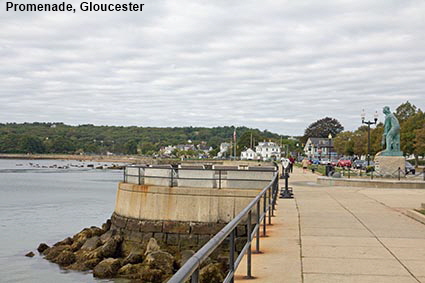
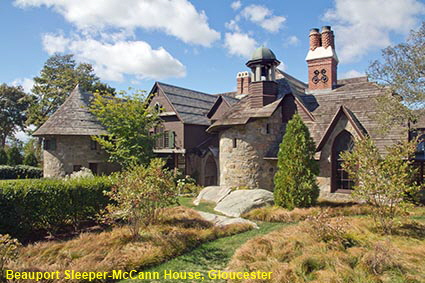
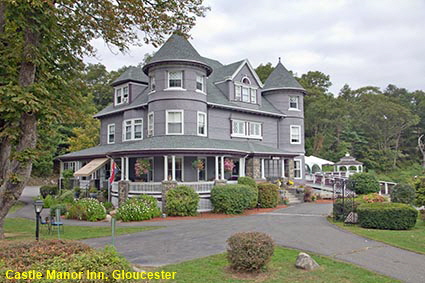
DLU171013
Click on Minimap to navigate


To move forwards or backwards through the Essex County trail click the arrows above, or select your next destination on the Minimap.
Castle Manor Inn, Gloucester
This Queen Anne style mansion was completed in 1900 as the home of glue magnate Ruben Brooks. Working with William Le Page he co-founded the Russia Cement Company. The company developed a glue, initially made from fish skins, which was marketed as Le Page’s Glue. It became a well known product throughout the USA and the company was eventually renamed after the glue. The house that Brooks commissioned was a very fine mansion, complete with an indoor bathroom which was quite a rarity in those days. The house passed through several hands and in the 1950s some motel units were built in the grounds to serve the growing tourist trade. In 2011 new owners renovated the house, creating a restaurant, 10 guest rooms and 16 motor lodge units. The former glue magnate’s mansion was relaunched as the Castle Manor Inn. And what of Lepage’s Glue? The company stayed in Gloucester until 2003 when it packed up and moved to Canada.
Beauport Sleeper-McCann House, Gloucester
Perched on a rocky ledge overlooking Gloucester Harbor is one of the most quirky houses in New England. It was the summer home of one of America’s first professional interior designers, Henry Davis Sleeper. Not only was it his retreat, it was also a showcase of his professional capabilities. Construction of the house that Sleeper called Beauport began in autumn 1907 and it was largely complete by May 1908. Sleeper extended Beauport several times until it had 56 rooms. He decorated each room with different different historical and literary themes. After his death in 1934 the house and its contents were bought by Charles and Helena McCann. They made a few modifications to the house but largely kept Sleeper’s designs and decoration intact. In 1947 after the death of the McCanns, their heirs donated the house to the Society for the Protection of New England Antiquities, now known as Historic New England. They operate the Beauport Sleeper-McCann House as a house museum. It is open Tuesday to Saturday, Memorial Day to Columbus Day. When we visited in 2013 the museum was still enforcing an increasingly futile ban on photographs of the interior, so sadly we can not show you a picture of the over-the-top interior of the house. Click Tab 2 to see the Dovecot built into the roof of the house.
Promenade, Gloucester
The Town of Gloucester was incorporated by the Massachusetts Bay Colony in 1642. An abundance of timber helped Gloucester to become a major ship building centre, specialising in a new type of vessel called a Schooner which was designed to be a fast fishing boat. Gloucester suffered during the Revolutionary War. Some schooners were being operated by privateers so the British destroyed virtually all of the town’s fleet. After the war, Gloucester quickly recovered as both a ship building centre and fishing port. By 1879 there were almost 450 fishing vessels sailing from the town employing over 5,000 men but fishing was a dangerous business with 32 vessels and 266 men lost in that year alone. From the mid 1800s Gloucester also became a port for shipping granite quarried on Cape Ann. In 1924 Clarence Birdseye invented a quick-freezing process for fish and set up General Seafood Corporation to exploit his invention. The company moved to Gloucester in 1925, and the modern frozen food industry was born. Overfishing and modern building materials resulted in the decline of both the fishing industry and granite quarrying. Nowdays Gloucester is primarily a tourist destination with a fine promenade for the tourists to stroll along
Home > US States > New England > Massachusetts > Essex County >
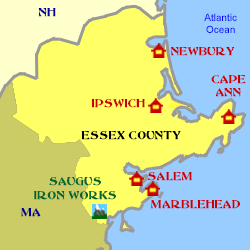
Rockport Harbor
Sandy Bay was originally a part of Gloucester where timber was obtained for its shipbuilding industry. Granite quarrying also began in the area and in 1680 a granite cutter called Richard Tarr was the first person to settle at Sandy Bay. In 1743 a dock called Rockport Harbor was built on Sandy Bay. It was used for shipping granite and as a base for a fishing fleet. The settlement became known as Rockport after the dock. and it 1840 the residents voted to separate from Gloucester. Rockport granite was used all over the USA, including the polished stone at the mouth of the Holland Tunnel in New York. Concrete has replaced granite for much building work, but the town of Rockport still thrives on tourism and as an artists colony. Click Tab to to see a view along Bearskin Neck in Rockport
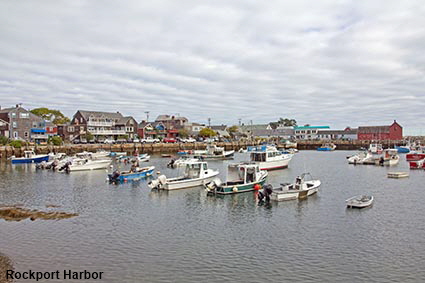

© Mike Elsden 1981 - 2025
The contents of this page may not be reproduced in full or in part without permission